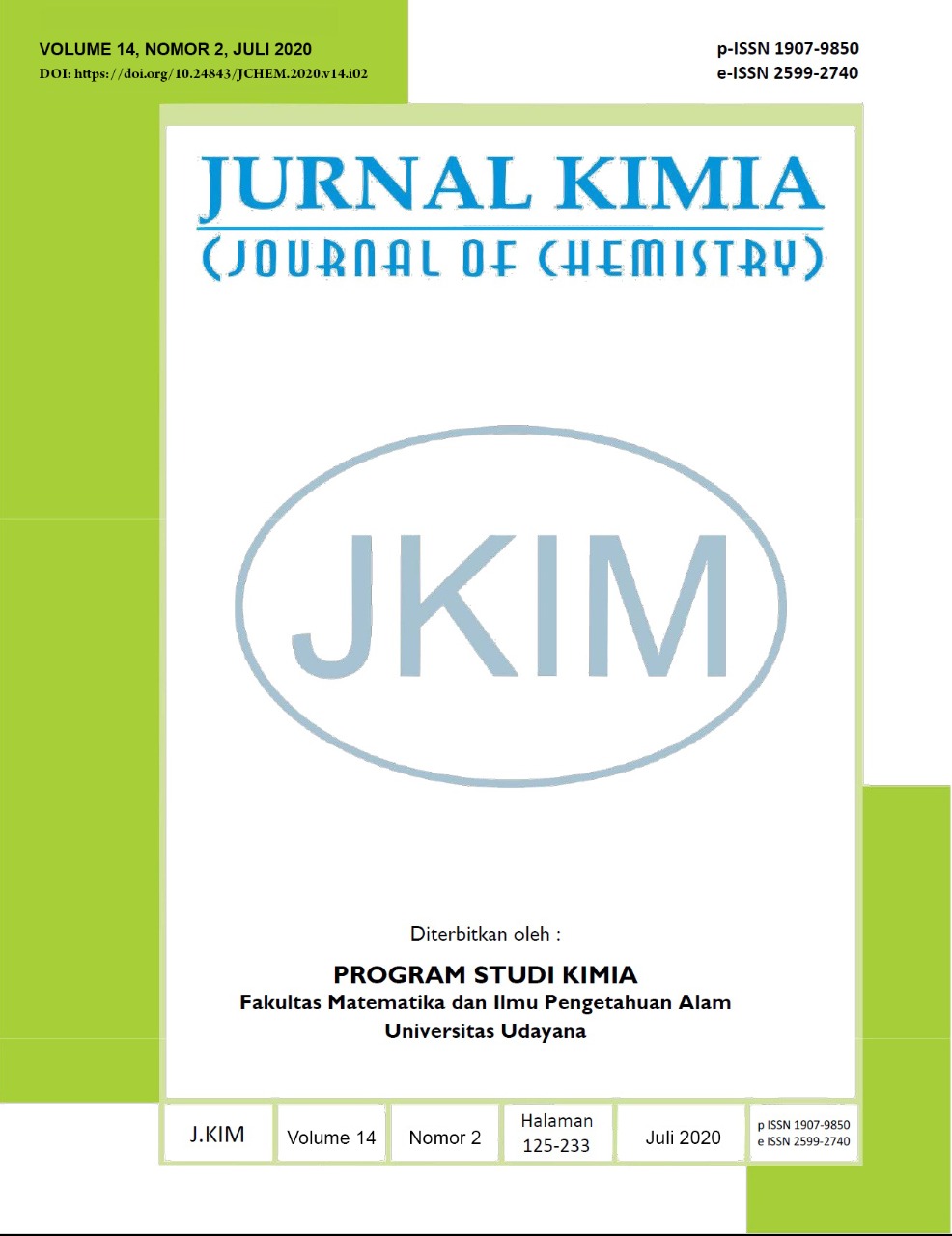PRODUKSI HIDROLISAT PROTEIN ANTIOKSIDAN MELALUI HIDROLISIS ENZIMATIK PROTEIN KULIT AYAM BROILER DENGAN ENZIM PAPAIN
Abstract
Penelitian ini bertujuan untuk menentukan aktivitas antioksidan hidrolisat protein yang dihasilkan dari proses hidrolisis enzimatik protein kulit ayam dengan menggunakan variasi konsentrasi enzim papain. Proses hidrolisis dilakukan dengan variasi konsentrasi enzim 1, 3,dan 5% (b/b protein), pada pH 7, suhu 50oC dan waktu hidrolisis 24 jam. Parameter yang diukur meliputi derajat hidrolisis, persen peredaman radikal DPPH (diphenylpicryl hidrazyl), dan komposisi asam amino hidrolisat protein yang paling aktif antioksidan. Hasil penelitian menunjukkan penggunaan konsentrasi enzim yang berbeda menghasikan hidrolisat protein dengan derajat hidrolisis dan persen peredaman DPPH yang berbeda. Penggunaan konsentrasi enzim papain 1, 3, dan 5% menghasilkan hidrolisat protein dengan derajat hidrolisis berturut-turut sebesar 9,3±1,8, 18,09±5,6, dan 23,15±6.33%, dan persentase hambatan radikal DPPH pada konsentrasi uji 100 ppm berturut-turut sebesar 16,75±0,07, 58,35±0,00, dan 52,99±0,07%. Hidrolisat protein yang diperoleh menggunakan enzim papain 3% (b/b protein) menunjukkan persen peredaman tertinggi dengan nilai IC50 92,98 ppm, memiliki komposisi asam amino tertiggi asam glutamat dan terendah valine.
Kata kunci: antioksidan, enzim papain, hidrolisat protein, kulit ayam
This study aimed to determine the antioxidant activity of protein hydrolyzate produced from the enzymatic hydrolysis of chicken skin protein by using variations of the enzyme papain concentration. The hydrolysis process was carried out with variations in the concentration of the enzymes 1, 3, and 5% (w/w protein base), at pH 7, temperature 50oC, and hydrolysis time 24 hours. The parameters measured including degree of hydrolysis, percentage of inhibition of DPPH radical (diphenylpicryl hydrazyl) and amino acid composition of the protein hydrolyzate with the highest antioxidant activity. The results showed that the use of different enzyme concentrations resulted in protein hydrolyzate with different degrees of hydrolysis and percentage of inhibition of DPPH. The use of papain enzymes 1, 3, and 5% produced protein hydrolyzate with the degree of hydrolysis of 9.3 ± 1.8, 18.09 ± 5.6, and 23.15 ± 6.33%, and the percentage of inhibition of DPPH radical at a concentration of 100 ppm 16.75 ± 0.07, 58.35 ± 0.00, and 52.99 ± 0.07% respectively. Protein hydrolyzate obtained using the enzyme papain 3% (w/w protein) exhibited the highest percentage of inhibition of DPPH with an IC50 value of 92.98 ppm, having the highest amino acid composition of glutamic acid and the lowest valine.
Keywords: antioxidant, enzyme papain, protein hydrolyzate, chicken skin
Downloads
References
Baehaki, A., Lestari, S. D., Romadhoni, A. R., 2015. Hidrolisis Protein Ikan Patin Menggunakan Enzim Papain dan Aktivitas Antioksidan Hidrolisatnya. JPHPI. 18(3): 108-118.
Beveridge, A.J. 1996. A Theoretical study of the active sites of papain and s195c rat tripsin:implication for the low reactivity of mutant serine proteinases. Journal Protein Sciences. 5:1355-1365.
Bougatef, A., Balti, R., Haddar, A., Jellouli, K., Souissi, N., Nasri, M. 2012. Antioxidant and functional properties of protein hydrolysates of bluefin tuna (Thunnus thynnus) head as influenced by the extent of enzymatic hyrolysis, Biotechnology and Bioprocess Engineering. 17: 841-852.
Castro, R. J. S., dan Sato, H. H. 2015. Review: Biologically active peptides: Process for their generation, purification and identification and application as natural additives in the food and pharmaceutical industries. Food Research International. 74: 185-198.
Chang, F.C., Bin, W., Yu, M.W., Bin, Z., Shang, G.D. 2015. Isolation and characterisation three antioxidant peptides from protein hydrolisate of bluefin leatherjacket (Navodon septenrionalis) heads. Jurnal of Functional Food. 12: 1-10.
Elevarsan, K., Naveen Kumar, V., Shamasundar, B. A. 2014. Antioxidant and Functional Properties of Fish protein Hydrolysate from Fresh Waer Carp (Catla-Catla) as influenced by the nature of enzyme. J. Food. Process.Press. doi:10.1111/jfpp.12081
He, R., Girgih, A.T., Malomo, S. A, Ju, X. R, Aluko, R.E. 2013. Antioxidant activities of enzymatic rapeseed protein hydrolysates and the membrane ultrafiltration fraction. Journal of Functional Food. 5(1): 219-227.
Kim, EK. 2013. Marine Protein and Peptides, Biological Activities, Oxford (UK):John Wiley and Sons.
Molyneux, P., 2004, The use of the stable free radical diphenylpicrylhydrazil (DPPH) for estimating antioidant activity, Journal Science and Technology, 26 (2):211-219.
Mutaminah, D., Ibrahim B., Trilaksani, W., 2018. Antioxidant activity of protein hydrolysate produced from tuna eye (Thunnus sp) by enzymatic hydrolysis. JPHPI. 21(3): 522-531.
Najafian, L., Abdul S.B. 2014. Production of bioactive peptides using enzymatic hydrolysis and identification antioxidative peptides from patin (Pangasius sutchi) sarcoplasmic protein hydrolysate. Journal of Functional Food. 9 (3): 280-289.
Naqash, S. Y. and Nazeer, R. A. 2014. Evaluation of bioactive peptides isolated from Exocoetus volitan backbone, International Journal of Food Sciences and Technology. 46: 37-43.
Nasri, M. 2017. Protein hydrolysate and biopeptide: Production, biological activities, and application in food and health benefit: A review. Advanced in Food and Nutrition Research. 81:105-109.
Onuh, J. O. 2015. Antyhypertensive and Antioxidant Properties of Chikcen Skin Protein Hydroysates: In vivo, in vitro, and metabolomic studies. Thesis. Faculty Of Grdauate Studies, The University of Manitoba.
Onuh, J. O., Girgih, A. T., Aluko, R. E, Aliani, M. 2014. In vitro antioxidant properties of chicken skin enzymatic protein hydrolysates and membrane fractions, Food Chem. 150: 366-373.
Puspawati, N. M., Widihati, I. G, dan Widana, N. 2015. Analisis Komposisi Asam Amino dan Pola Pita protein Gelatin Halal dari Kulit Ayam Broiler, Laporan Penelitian Unggulan Program Studi, FMIPA, Universitas Udayana.
Samanarayaka, E. G. P. and Li-Chan, E. C. Y., 2011. Food-derived peptidic antioxidant: a review of their production, assesment and potential applications. Journal of Functional Food. 3:229-254.
Susanto, E, Rosyidi, D., Radiati, L. E. 2018. Optimasi aktivitas peptida aktif dari ceker ayam melalui hidrolisis enzim papain, Jurnal Ilmu dan Teknologi Hasil Ternak. 13(1): 14-26.
You, L., Zhao, M., Cui, C., Zhao, H., Yang, B. 2009. Effect of degree of hydrolysis on the antioxidant activity of loach (Misgurnusanguilli caudatus) protein hydrolysates. Innovative Food Sciences and Emerging Technology. 10(2): 235-240.

This work is licensed under a Creative Commons Attribution 4.0 International License






